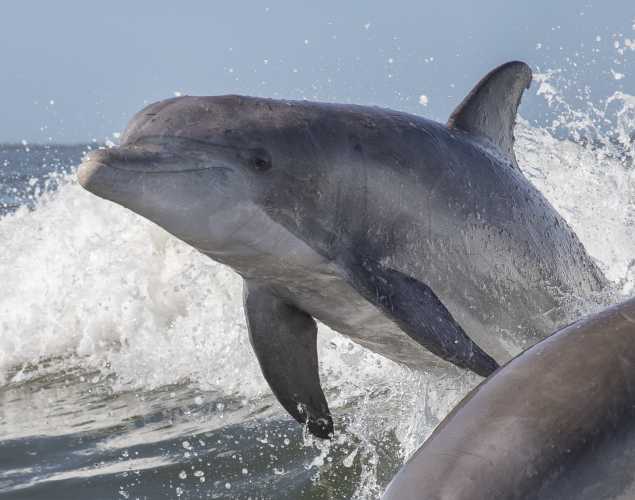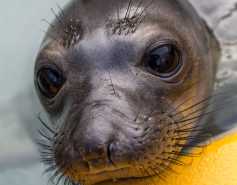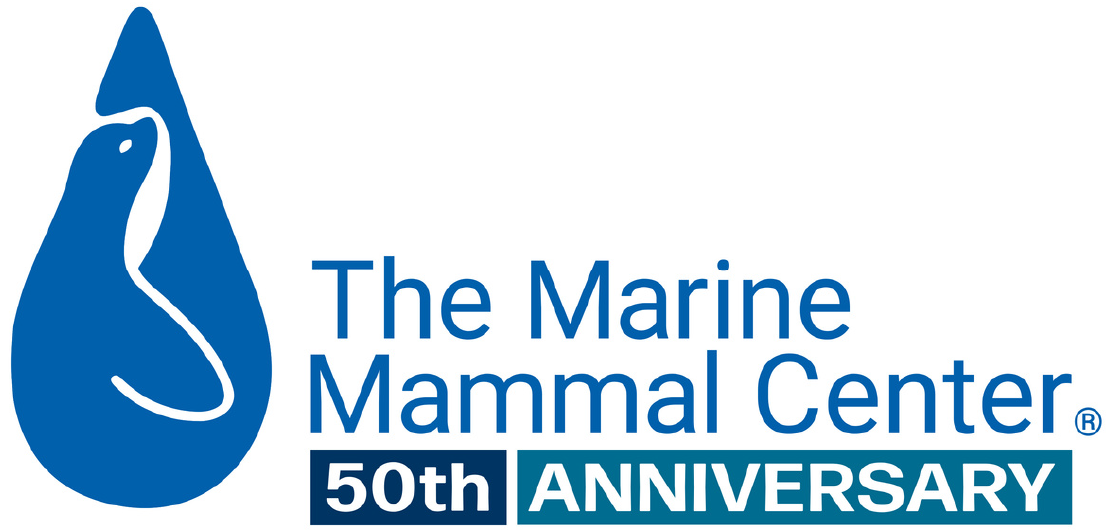
Clinical Management of Candida Albicans Keratomycosis in a Bottlenose Dolphin
- Medicine
Abstract
Objective: Corneal ulceration secondary to trauma commonly affects marine mammals, often with opportunistic secondary bacterial or fungal infections. This report characterizes the combined use of auriculopalpebral and ophthalmic nerve blocks, adipose-derived stem cells, and subconjunctival injections for successful treatment of corneal trauma and infection in dolphins.
Animal studied: An 11-year-old, female bottlenose dolphin (Tursiops truncatus) presented with bilateral diffuse corneal opacities, which progressed to keratomycosis caused by Candida albicans.
Procedure: Aggressive medical management was employed, including the use of subconjunctival injections of adipose-derived stem cells, plasma, topical and oral antifungals and antibiotics, and anti-inflammatory and pain medications. Anesthetic block of the auriculopalpebral and ophthalmic nerves was employed to evaluate the corneas.
Conclusion: Subconjunctival injections were employed over 52 days, followed by topical drops for 5 months. At last evaluation, there was no evidence of blepharospasm bilaterally. Only a faint superficial gray corneal opacity remained OS. A temporal paraxial corneal opacity was present OD, with receding inactive vascularization and a small amount of melanosis temporally.
Simeone, C.A., Traversi, J.P., Meegan, J.M., LeBert, Colitz, C.M.H., Jensen, E.D. 2017. Clinical management of Candida albicans keratomycosis in a bottlenose dolphin (Tursiops truncatus). Veterinary Opthamology. (2017): 1-7.
Related Publications
{"image":"\/Animals\/Patients\/Elephant seals\/cropped-images\/es-by-bill-hunnewell-c-the-marine-mammal-center-3-2-1214-3454-3512-1600891002.jpg","alt":"northern elephant seal","title":"Diagnostic Tests for Lungworm-Infected Northern Elephant Seals","link_url":"https:\/\/www.marinemammalcenter.org\/publications\/diagnostic-tests-for-lungworm-infected-northern-elephant-seals","label":"Research Paper"}

{"image":"\/Animals\/Patients\/California sea lions\/cropped-images\/csl-by-bill-hunnewell-c-the-marine-mammal-center-7-0-1446-2827-2208-1603918668.jpg","alt":"California sea lion on pool ledge","title":"Effectiveness of Antibiotics in Treating Leptospirosis in California Sea Lions","link_url":"https:\/\/www.marinemammalcenter.org\/publications\/effectiveness-of-antibiotics-in-treating-leptospirosis-in-california-sea-lions","label":"Research Paper"}

Effectiveness of Antibiotics in Treating Leptospirosis in California Sea Lions
Read More{"image":"\/Animals\/Wild\/Elephant seal\/cropped-images\/elephant-seal-bull-shutterstock-640-0-3728-2911-1626818513.jpg","alt":"large northern elephant seal on a beach","title":"Use of Potassium Chloride for Low-Residue Euthanasia of Anesthetized Seals and Sea Lions","link_url":"https:\/\/www.marinemammalcenter.org\/publications\/use-of-potassium-chloride-for-low-residue-euthanasia-of-anesthetized-seals-and-sea-lions","label":"Research Paper"}

Use of Potassium Chloride for Low-Residue Euthanasia of Anesthetized Seals and Sea Lions
Read More{"image":"\/Animals\/Wild\/Other species\/cropped-images\/weddell-seal-shutterstock-256-0-3788-2959-1639535584.jpg","alt":"Weddell seal laying on the ice","title":"A Safe and Effective Reversible Field Sedation Protocol for Weddell Seal Pups","link_url":"https:\/\/www.marinemammalcenter.org\/publications\/a-safe-and-effective-reversible-field-sedation-protocol-for-weddell-seal-pups","label":"Research Paper"}

A Safe and Effective Reversible Field Sedation Protocol for Weddell Seal Pups
Read MoreRelated News
{"image":"\/Animals\/Patients\/Elephant seals\/cropped-images\/es-hoffman47927-photo-by-bill-hunnewell-c-the-marine-mammal-center-124-0-1270-992-1748384535.jpg","alt":"An An elephant seal\u2019s face with long black whiskers and wide eyes emerges from the water. ","title":"Adaptations of the Deep: Seal Whiskers and Eyes","link_url":"https:\/\/www.marinemammalcenter.org\/news\/adaptations-of-the-deep-seal-whiskers-and-eyes","label":"Patient Update","date":"2025-05-28 02:00:00"}

{"image":"\/Animals\/Wild\/Elephant seal\/cropped-images\/01. SNI Andromeda_NOAA permit-174-0-1270-992-1733414759.jpg","alt":"A northern elephant seal with a satellite tag on its head on the beach in front of crashing waves. ","title":"Studying Elephant Seals of the Central California Coast","link_url":"https:\/\/www.marinemammalcenter.org\/news\/studying-elephant-seals-of-the-central-california-coast","label":"News Update","date":"2024-12-06 12:21:47"}

{"image":"\/Animals\/Patients\/California sea lions\/2022\/cropped-images\/csl-torple-by-bill-hunnewell-c-the-marine-mammal-center-6-10-4475-3495-1664989112.jpg","alt":"California sea lion Torple in a pool with her head in the air","title":"SFGATE: Hundreds of Sea Lions Sickened Along California Coastline","link_url":"https:\/\/www.marinemammalcenter.org\/news\/sfgate-hundreds-of-sea-lions-sickened-along-california-coastline","label":"In the News","date":"2022-10-05 02:00:00"}

SFGATE: Hundreds of Sea Lions Sickened Along California Coastline
October 5, 2022
Read More{"image":"\/Animals\/Patients\/California sea lions\/2014\/cropped-images\/csl-orchard-photo-c-the-marine-mammal-center-1350-74-2950-2304-1713994848.jpg","alt":"California sea lion Orchard","title":"The Curious Case of the Sea Lion That Couldn\u2019t Catch His Breath","link_url":"https:\/\/www.marinemammalcenter.org\/news\/the-curious-case-of-the-sea-lion-that-couldnt-catch-his-breath","label":"Patient Update","date":"2014-11-19 01:00:00"}

The Curious Case of the Sea Lion That Couldn’t Catch His Breath
November 19, 2014
Read More